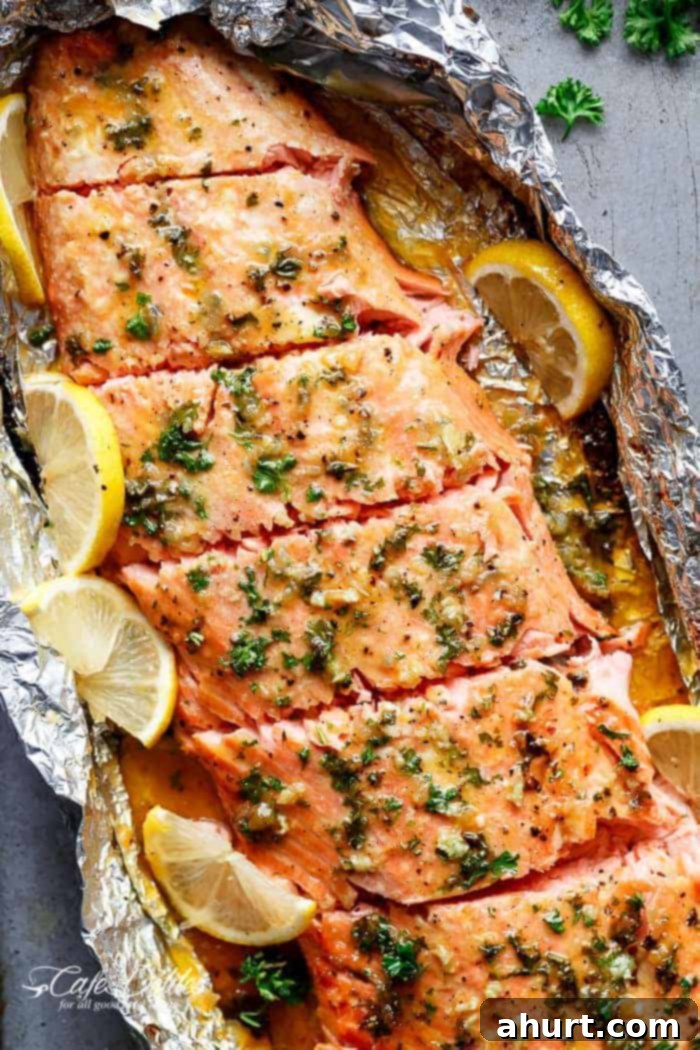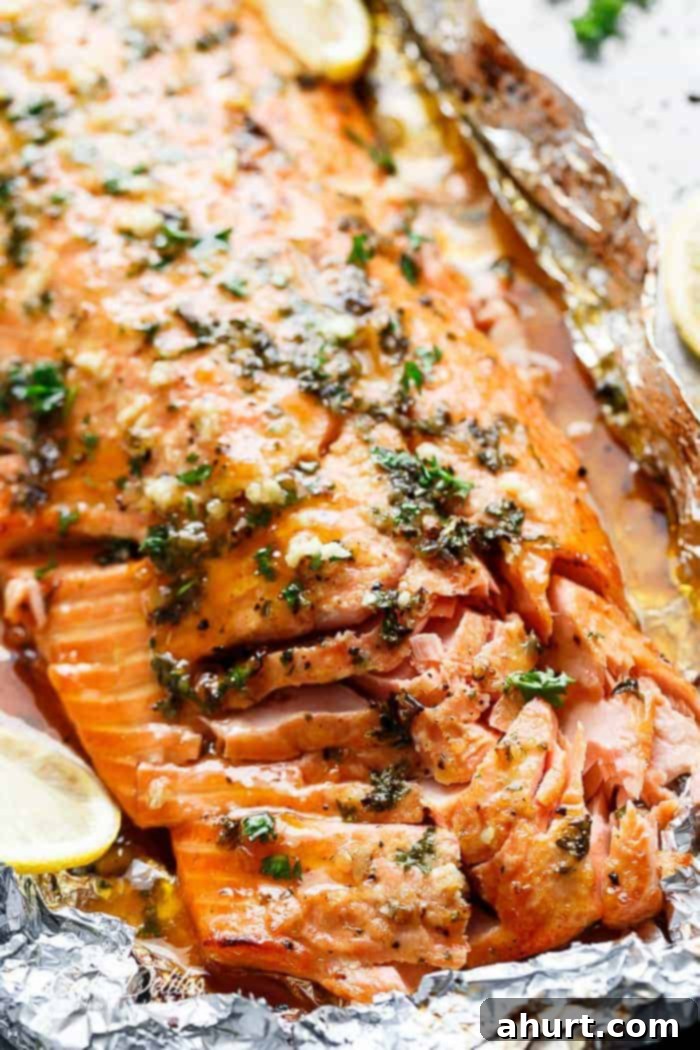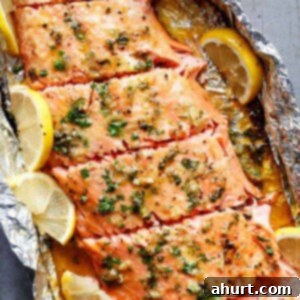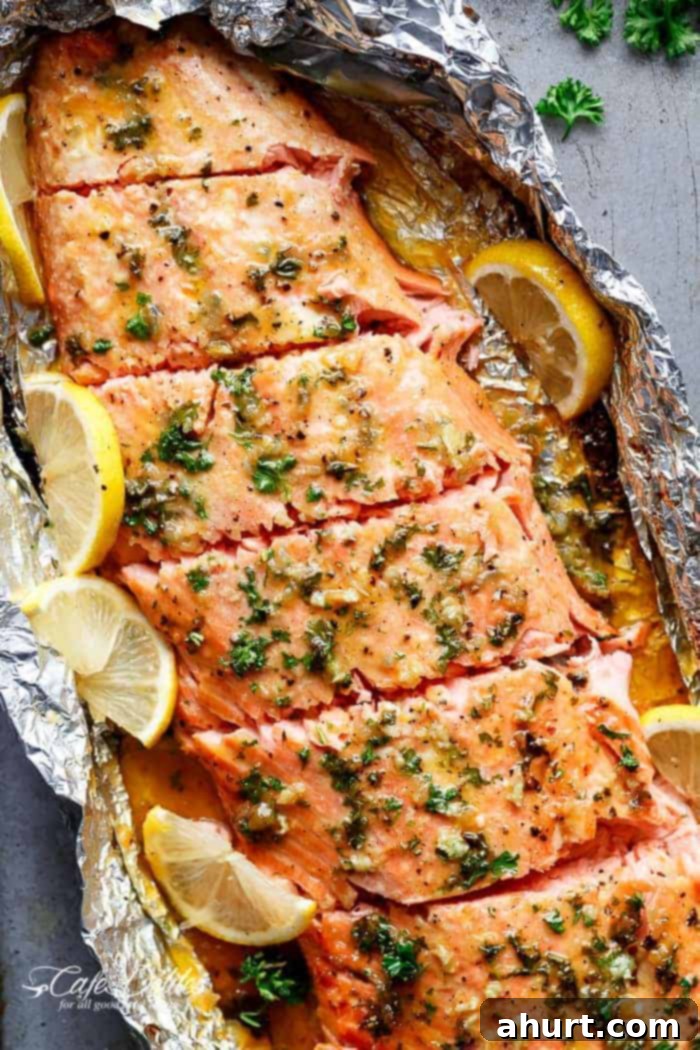Baked Honey Garlic Salmon in Foil: The Ultimate Easy & Flavorful Weeknight Dinner
This Honey Garlic Salmon, baked to perfection in a foil packet, is the epitome of an effortless yet incredibly delicious meal. Perfect for bustling weeknights or leisurely weekend dining, this recipe transforms simple ingredients into a gourmet-tasting dish with minimal fuss and, perhaps best of all, hardly any cleanup. The magic happens within the foil, where the salmon steams in its own juices, infused with a rich, aromatic honey-garlic sauce.
The secret lies in a vibrant honey-garlic sauce crafted from just a handful of everyday ingredients. This luscious glaze coats the salmon, sealing in moisture and flavor as it bakes, ensuring every bite is tender and succulent. For that irresistible golden-brown finish and perfectly caramelized edges, a quick broil at the end (or a finish on the grill) elevates this dish to new heights. Prepare to discover why this is hands down the BEST baked salmon recipe you’ll ever add to your repertoire!

The Secret to Irresistible Honey Garlic Salmon in Foil
The sheer brilliance of this Honey Garlic Salmon in Foil lies in its straightforward approach and phenomenal flavor payoff. By combining just a few pantry staples—honey, fresh garlic, butter, and a touch of lemon juice—you create a glossy, deeply flavorful glaze that infuses every delicate flake of the salmon. This balance of sweet and savory, with a vibrant garlicky kick, makes it truly addictive and a standout dish for any occasion.
Cooking salmon in a foil packet is a culinary game-changer. It creates a steamy environment that gently cooks the fish, locking in all its natural moisture and the rich, buttery goodness of the sauce. This method ensures your salmon is incredibly tender, juicy, and never dry. The foil also acts as a flavor incubator, allowing the honey-garlic glaze to penetrate deeply, resulting in a perfectly seasoned fillet. Furthermore, this technique simplifies cleanup immensely, turning a potential chore into a breeze.
To achieve that coveted restaurant-quality finish, a quick stint under the broiler is key. This high heat caramelizes the honey-garlic sauce on the surface, creating a beautiful golden crust and crispy edges without overcooking the delicate fish within. The result is a symphony of textures and flavors: tender, flaky salmon with a sticky, sweet, and savory exterior. Minimal prep, maximum flavor, and effortless cleanup—this recipe is an absolute keeper for busy cooks who refuse to compromise on taste.
Essential Ingredients for Your Honey Garlic Salmon
This recipe celebrates simplicity, relying on fresh, high-quality ingredients that harmonize to create a sticky, buttery glaze you’ll find yourself wanting to put on everything. Each component plays a crucial role in developing the incredible depth of flavor. Here’s a closer look at what you’ll need to prepare this irresistible Honey Garlic Salmon:
- Butter: This forms the luxurious, rich base of our sauce. As it melts, it envelops the salmon, ensuring it remains incredibly tender and moist throughout the baking process while adding a luscious depth of flavor that complements the other ingredients beautifully.
- Honey: Beyond just adding natural sweetness, honey is vital for achieving that gorgeous caramelization during the broiling stage. It provides a delightful counterpoint to the savory garlic and creates a sticky, irresistible glaze that clings to every part of the salmon.
- Garlic: Freshly crushed garlic cloves are the heart of this savory sauce. They infuse the butter and honey with a bold, aromatic depth that perfectly balances the sweetness, making the glaze incredibly savory and complex. Don’t skimp on fresh garlic for the best results!
- Lemon Juice: Freshly squeezed lemon juice adds a bright, zesty tang that cuts through the richness of the butter and sweetness of the honey. It elevates the entire flavor profile, making the sauce more vibrant and giving the salmon a refreshing lift.
- Salmon: While individual fillets work, a whole side of salmon is truly ideal for this recipe. It cooks more evenly in the foil packet, allowing the entire piece to soak up every drop of that glorious honey-garlic butter. Look for fresh, vibrant pink salmon with firm flesh for the best taste and texture.
- Salt and Cracked Pepper: Essential seasonings that enhance the natural flavors of the salmon and the sauce. A good pinch of salt brings out the sweetness of the honey and the savory notes of the garlic, while freshly cracked black pepper adds a subtle warmth and aromatic finish.
- Fresh Parsley (for garnish): While optional, a sprinkle of fresh chopped parsley at the end adds a burst of vibrant color and a fresh, herbaceous note that brightens the dish and makes it visually appealing.
Note: Please see recipe card at the bottom for a full list of ingredients with precise measurements.
Step-by-Step Guide: Crafting Your Perfect Honey Garlic Salmon
Making this incredible Honey Garlic Salmon is simpler than you might think. Follow these easy steps to achieve a perfectly cooked, flavor-packed fish that will impress everyone at your table.
- Preheat the Oven and Prepare Foil: Start by preheating your oven to 375°F (190°C) and positioning an oven rack in the middle. This ensures even cooking. Next, line a sturdy baking sheet with a large piece of heavy-duty aluminum foil. Make sure the foil is long enough to completely fold over and seal your salmon fillet securely, creating a tight packet. You might even use two overlapping sheets for a larger salmon side to ensure full coverage and prevent any delicious sauce from leaking.
- Make the Honey Garlic Sauce: In a small saucepan, melt the butter over a low to medium heat. Once melted, add the honey, freshly crushed garlic, and the bright, tangy lemon juice. Whisk these ingredients together thoroughly until the mixture is smooth and beautifully combined. The goal is a homogenous sauce where all the flavors can meld. Remove the saucepan from the heat once combined, as you don’t want to cook the garlic too much at this stage.
- Prepare and Place Salmon: Carefully place your salmon fillet, skin-side down, onto the center of your prepared foil-lined baking tray. Before adding the sauce, gently pat the salmon dry with a paper towel. This crucial step removes any excess moisture from the fish’s surface, allowing the honey-garlic sauce to adhere better and create a more even, flavorful crust.
- Generously Coat with Sauce: Now, take your luscious honey-garlic butter sauce and pour it evenly over the entire surface of the salmon. Use a spoon or a pastry brush to ensure every part of the fish is thoroughly coated with this flavorful glaze. Don’t be shy – the more sauce, the more flavor will be locked in.
- Season and Garnish: Season the salmon generously with salt and a pinch of freshly cracked black pepper to taste. For an extra burst of fresh flavor and a beautiful presentation, arrange a few thin lemon slices directly on top of or around the fish. As it bakes, the lemon will release its aromatic oils, infusing the salmon with a wonderful citrusy note.
- Seal the Foil Packet: Bring the long sides of the aluminum foil together over the salmon. Carefully fold and crimp the edges tightly to create a sealed packet. Ensure there are no gaps, as this tight seal is essential for trapping all the moisture and flavor inside, allowing the salmon to steam perfectly in its delicious sauce. This also prevents any buttery goodness from leaking onto your baking sheet.
- Bake to Perfection: Place the prepared baking tray with the sealed foil packet into your preheated oven. Bake for approximately 15 to 18 minutes. The exact baking time will depend on the thickness of your salmon fillet and your desired level of doneness. Salmon is typically cooked when it flakes easily with a fork and reaches an internal temperature of 145°F (63°C).
- Broil for Caramelization & Serve: Once baked, carefully remove the tray from the oven. Gently open the foil packet, being cautious of the hot steam that will escape. Place the tray back under the broiler for 2 to 3 minutes. Keep a close eye on it, as the honey in the sauce can caramelize and brown quickly. This step creates those irresistible crispy, golden-brown edges. Garnish generously with fresh chopped parsley and serve immediately with extra lemon slices on the side. Enjoy!
Perfect Side Dishes for Honey Garlic Salmon
This Honey Garlic Salmon is a star on its own, but it pairs beautifully with simple, complementary sides that can soak up the extra sauce and truly let the fish shine. Here are some fantastic suggestions:
- Potatoes: Fluffy mashed potatoes are a classic for a reason. Their creamy texture is perfect for spooning over that buttery honey-garlic glaze. Roasted baby potatoes or a simple baked potato would also be excellent choices.
- Rice and Grains: A bowl of light, fluffy white rice or even a healthier option like quinoa or couscous makes a wonderful bed for the salmon, absorbing all the delicious juices. For a low-carb alternative, Cauliflower Fried Rice makes a surprisingly satisfying companion.
- Green Vegetables: To add a fresh, crisp contrast, consider vibrant green vegetables. Simple garlic green beans, roasted asparagus, or steamed broccoli complement the rich salmon without overpowering it. A light drizzle of olive oil and a squeeze of lemon are all they need.
- Salads: For a lighter meal, a fresh, lemony arugula salad or a mixed green salad with a simple vinaigrette offers a refreshing brightness and a delightful textural contrast to the tender fish.
Whatever you choose, remember to keep it relatively simple – the star of this meal is undeniably the succulent Honey Garlic Salmon.
Pro Tips for the Best Honey Garlic Salmon
- Use Fresh Garlic: While garlic powder can be convenient, fresh garlic cloves are essential for the bold, aromatic flavor profile of this sauce. Crush them just before use for maximum impact.
- Pat Salmon Dry: Don’t skip this step! A dry surface allows the sauce to adhere better, leading to superior flavor absorption and a more appetizing caramelization during broiling.
- Don’t Overcook: Salmon cooks quickly. Overcooked salmon becomes dry and tough. Keep an eye on it during baking and broiling. The internal temperature for cooked salmon should reach 145°F (63°C). It will continue to cook slightly after removal.
- Heavy-Duty Foil: Using heavy-duty aluminum foil (or two layers of standard foil) is crucial to prevent tearing and ensure a tight seal, which locks in moisture and prevents leaks.
- Broil Carefully: The honey in the sauce can burn quickly under the broiler. Stay vigilant and watch it constantly, typically 2-3 minutes is all it needs for that golden finish.
- Consider Adding Veggies: For a complete one-pan meal, you can add quick-cooking vegetables like thinly sliced asparagus, broccoli florets, or bell peppers to the foil packet alongside the salmon for the last 10 minutes of baking.
Frequently Asked Questions (FAQ’s)
Yes, absolutely! Just ensure your frozen salmon is fully thawed before you begin. Place it in the refrigerator overnight, or for a quicker thaw, submerge the sealed salmon in cold water. Once thawed, pat it very dry with paper towels to ensure the honey-garlic sauce adheres properly and the fish cooks evenly.
Certainly! If you prefer individual salmon fillets, they work perfectly well. The main adjustment you’ll need to make is to the baking time, as fillets are generally thinner and cook faster than a whole side of salmon. Aim for approximately 10–12 minutes of baking time, or until the salmon is flaky and reaches an internal temperature of 145°F (63°C).
Absolutely, grilling is a fantastic alternative, especially for adding a smoky flavor! Prepare the salmon in the foil packet exactly as directed in the recipe. Place the sealed foil packet directly on a preheated grill over medium heat for about 15 minutes, or until cooked through. Then, carefully open the foil to expose the salmon, allowing it to char slightly and caramelize the sauce for a few extra minutes before serving.
You can prep the honey garlic sauce a day or two in advance and store it in an airtight container in the refrigerator. When ready to cook, gently warm the sauce to make it pourable, then proceed with the recipe as usual. We recommend cooking the salmon fresh for the best texture and flavor, rather than assembling the entire packet too far in advance.
Leftover Honey Garlic Salmon can be stored in an airtight container in the refrigerator for up to 2-3 days. To reheat, gently warm it in a preheated oven at 275°F (135°C) for about 10-15 minutes, or until just heated through, to prevent it from drying out. Avoid high heat or microwaving, which can make salmon rubbery.


Pin
Honey Garlic Butter Salmon In Foil
Ingredients
- 1/4 cup butter
- 1/3 cup honey
- 4 cloves garlic large, crushed
- 2 tablespoons lemon juice freshly squeezed, juice of 1/2 a lemon
- 2 1/2 pound side of salmon
- 1 pinch salt to taste
- 1 pinch cracked pepper to taste – optional
- 4-5 lemon slices to serve
- 2 tablespoons fresh parsley chopped
Instructions
-
Preheat your oven to 375°F (190°C) and position a rack in the center. Line a baking sheet with a large sheet of foil, making sure it’s long enough to wrap and seal the salmon fully.
-
In a small saucepan over low-medium heat, melt the butter. Stir in the honey, crushed garlic, and lemon juice. Whisk until smooth and fully combined, then remove from heat.
-
Place the salmon fillet skin-side down on the foil-lined tray. Pat it dry with a paper towel to remove excess moisture and help the sauce adhere better.
-
Pour the honey garlic butter evenly over the salmon. Use a spoon or brush to spread it across the surface. Season with salt, cracked pepper, and top with lemon slices for added flavor.
-
Fold the foil over the salmon and crimp the edges to seal it into a packet. Bake for 15 to 18 minutes, depending on the thickness of the fillet and your preferred doneness.
Notes
- I use two sheets of foil when wrapping my salmon to ensure it completely wraps around the width of the fillet. This provides a more secure packet, preventing steam and sauce from escaping, which leads to a juicier and more flavorful salmon.
Nutrition
Nutrition information is automatically calculated, so should only be used as an approximation.
